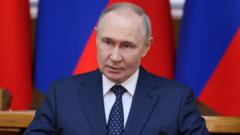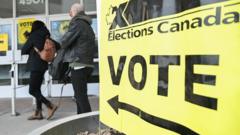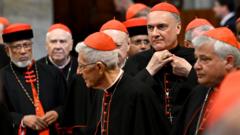On April 28, 2025, Canadians cast their votes in a consequential election shaped by President Trump's tariff threats and the abrupt political shift following Justin Trudeau's resignation. The leaders of the Liberal Party, Mark Carney, and the Conservative Party, Pierre Poilievre, embody contrasting visions for the nation's future amidst rising living costs and economic instability.
Canadians Vote Amidst Economic Turmoil and Political Shifts

Canadians Vote Amidst Economic Turmoil and Political Shifts
As Canada heads to the polls, the political landscape has been dramatically altered by President Trump's economic policies, with both the Liberal and Conservative parties vying for leadership.
Canadians are casting their ballots today in a critical election that will not only decide the country’s next leader but also its approach to the economic turmoil exacerbated by President Trump’s policies. Prime Minister Mark Carney, leading the Liberal Party, appears to have pulled ahead of Conservative leader Pierre Poilievre, reversing what was once the latter's significant lead just months ago.
In recent weeks, the Liberal Party gained momentum partly due to Carney’s rapid ascent after the resignation of Justin Trudeau, along with mounting concerns about Trump’s tariffs and their potential impact on the economy. Analysts indicate that public sentiment has swung favorably towards the Liberals, reflecting a perception that Carney has the expertise needed to manage relations with the U.S. effectively.
Amid this election, six other parties are competing, including the New Democratic Party (NDP) and the Bloc Québécois, but the spotlight remains on the two main contenders. With inflation and housing affordability rapidly becoming pivotal issues for many voters, the race has transformed into a referendum on economic management during a period marked by international uncertainties.
Polls opened at staggered times across Canada’s six time zones, with most closing at 9:30 p.m. ET. Counting votes manually adds to the anticipation, as early indications suggest a tight contest. The result may hinge not just on voter preference but also on regional trends, especially in populous areas like Ontario and Quebec, where both parties are vying for an edge.
Carney, with his prestigious background from global financial institutions, positions himself as the candidate capable of neutralizing Trump’s threats. In contrast, Poilievre, whose platform leans towards deregulation and anti-establishment rhetoric, faces challenges as many voters perceive him as too closely aligned with Trump at a moment when U.S.-Canada relations are critically strained.
As Canadians make their decisions today, the ramifications of their choices extend beyond mere electoral outcomes; they will likely shape the future socio-economic landscape and the nation’s stance against external pressures, particularly from the south.






















